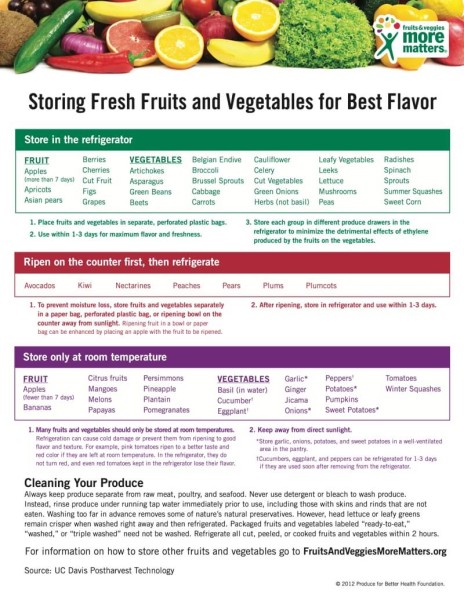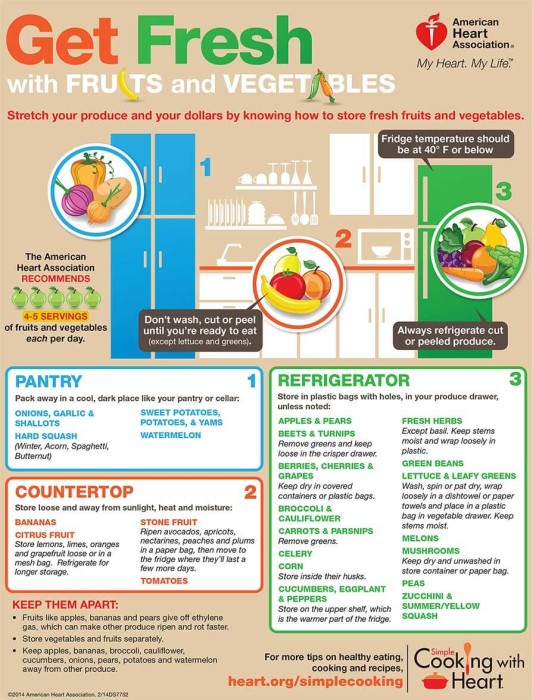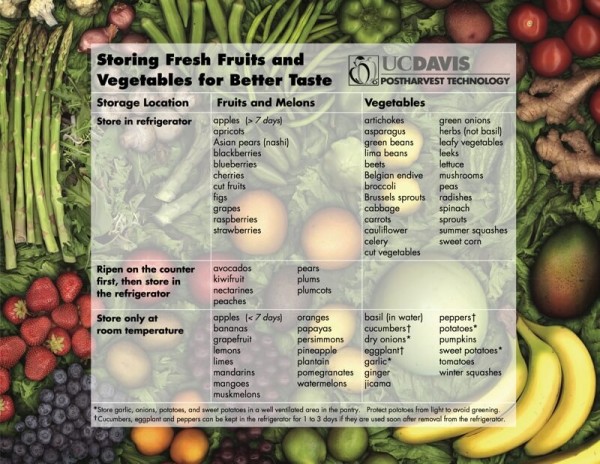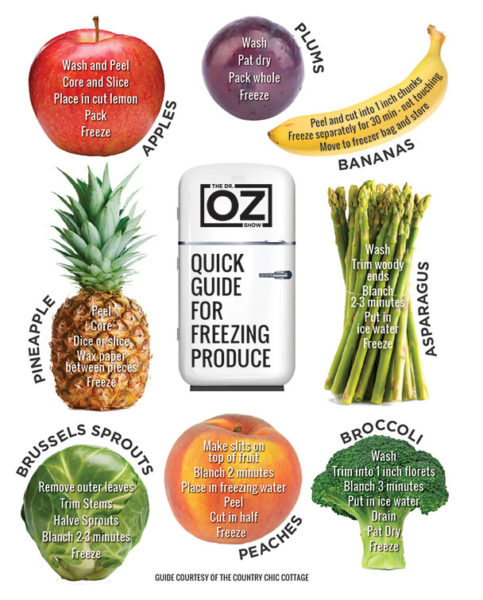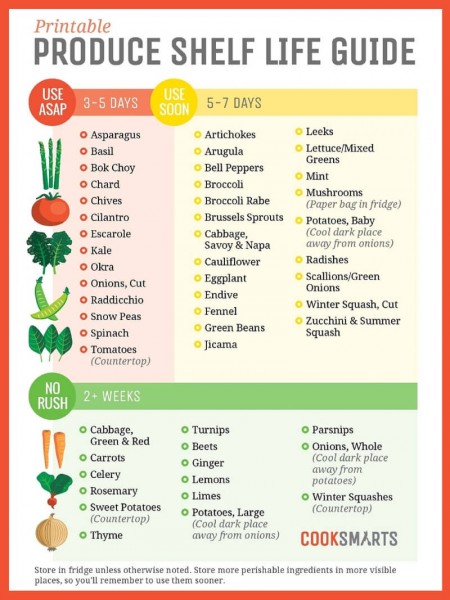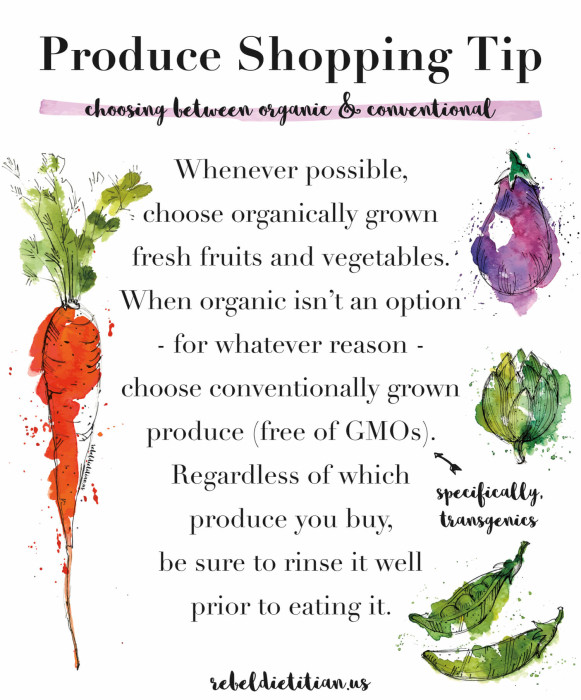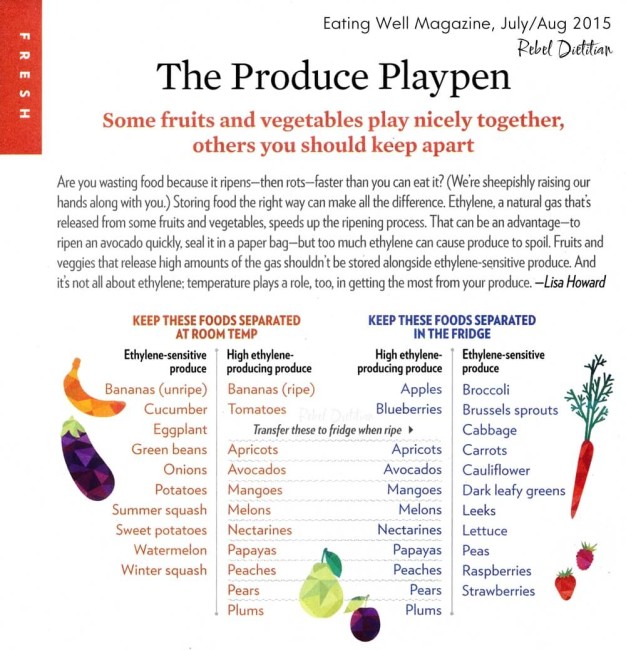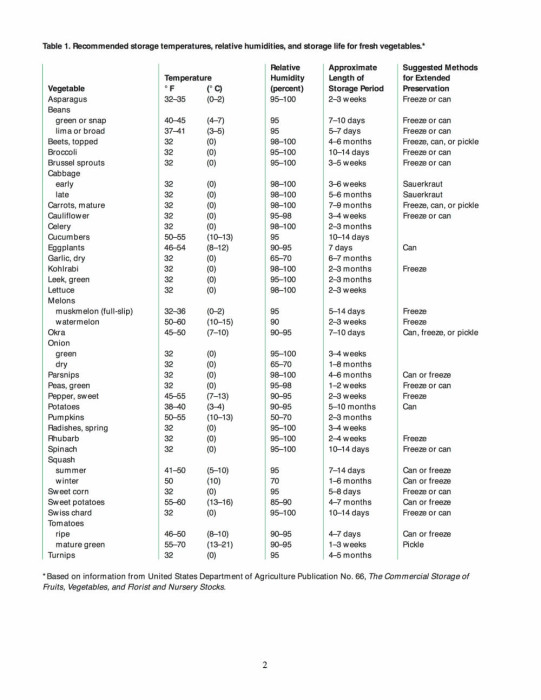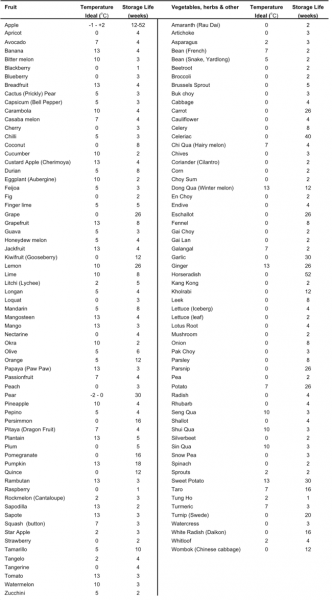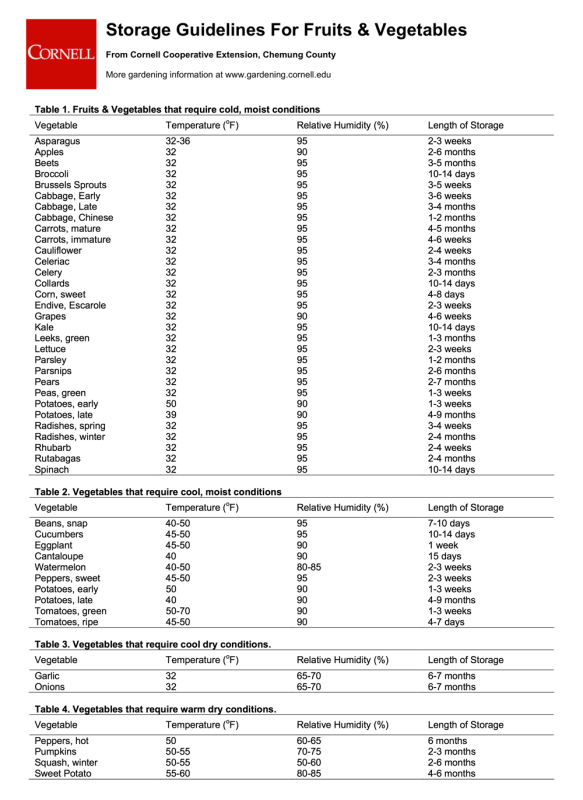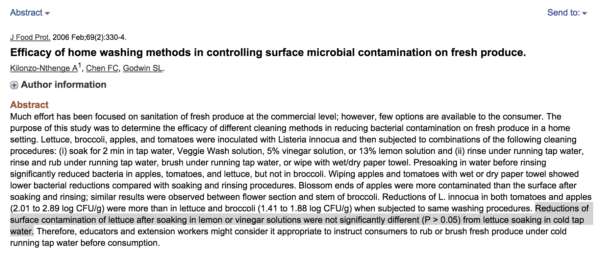Below I review produce specific storage and handling tips. You’ll also find relevant posters and charts. Enjoy and best of luck! xo, Dana
- Cleaning Produce
- Fruit
- Vegetables
- Greens
- Herbs
Cleaning Fresh Produce
Under cold running water, gently rub (or scrub) fresh produce using a produce brush to remove potentially harmful surface contaminants (e.g., microorganisms, pesticides, and other environmental contaminants). Do not use the kitchen sponge to clean fresh produce.
Which washing method is most effective?
No washing method completely removes or kills all microbes which may be present on produce but studies have shown that rinsing fresh produce under clean running — with or without a produce brush — is fairly effective (here and here).
What do you use to clean your produce?
I personally use a “natural” fruit and veggie wash that contains natural citrus oil to clean my produce. It’s the only product that I find to even remotely remove the contaminants and wax. While I have not tested this theory in a lab, there is evidence to support this position (here and here). Do not wash fruits and vegetables with harsh chemicals, detergents, or bleach solutions. Many types of fresh produce are porous and could absorb these chemicals, changing their safety and taste.
What about soaking in apple cider vinegar (ACV)?
I personally tried an apple cider vinegar (ACV) soak a while back, but it did not work for me. In fact, it promoted spoilage and may result in microbial contamination. After my experiment, I ran across a few research studies that suggest the ACV soaking method is no more effective than water, but if it works for you, great. If you decide to use the soaking method — any soaking method — skip the kitchen sink and soak your fresh produce in a clean bowl to avoid contamination, instead.
When should I wash it?
Rinsing fresh produce promotes spoilage, so wait to rinse fresh produce just before you are ready to eat (or serve) it. Reducing transport time (i.e., reducing the time spent shopping, driving, and unpacking) will also reduce spoilage.
Should I peel fresh produce to reduce exposure to contaminants?
Washing and then peeling fresh fruits and vegetables may reduce pesticide exposure; however, it also reduces your intake of important nutrients such as fiber. The health benefits associated with increasing intake of fresh fruits and vegetables outweighs the potential health risks associated with pesticide exposure.
Can I freeze fresh produce?
Yes, see the page titled Freezing Fresh Produce for more information.
Storage of Fresh Fruit
Apples
Apples are ethylene gas producers so store away from other produce. They can be stored on the counter for up to a week or in the fridge for more than a week.
Avocados
Ripen on the counter then store in the refrigerator.
Bananas
Keep green bananas out of the refrigerator and let them ripen on the counter. Once ripe, you can store them in the refrigerator for an extra 2 to 3 days to extend the shelf life. The outside will darken, but the fruit will still be edible.
Berries
Blueberries, blackberries, strawberries and raspberries are delicate and should not be washed until ready to eat. Keep in refrigerator in dry, covered containers.
Cherries and Grapes
Store in refrigerator, unwashed, in their original packaging or a glass or BPA-free container until ready to wash and eat.
Citrus Fruit
Extend the shelf life of clementines, grapefruit, lemons, limes and oranges by storing them in the crisper drawer or in a mesh bag in the refrigerator.
Melons
Store cantaloupe and honeydew loose in the refrigerator, even before they’re cut. Watermelon can be kept in a dark, dry place away from other produce. Keep cut melon in the fridge.
Stone Fruit
Keep nectarines, peaches and plums in a paper bag on the counter until they are ripe. Once ripe, you can move them to the refrigerator where they’ll last a few more days.
Tomatoes
Always store at room temperature as the refrigerator will make them rot quickly. Keep loose in a bowl away from sun or heat (like the stove).
To learn more about fruits and vegetables, visit the page titled Fruits and Vegetables.
Vegetable Storage
Broccoli and Cauliflower
Broccoli and cauliflower are best kept in separate refrigerator drawers away from other produce.
Celery
Store in the refrigerator.
Corn
Store in the refrigerator inside their husks. No, not all corn is GMO. I purchase non-GMO verified frozen corn.
Cucumbers
Store at room temperature. Can be kept in the refrigerator for 1 to 3 days if they are used soon after removal from the refrigerator.
Eggplant
Store at room temperature. Can be kept in the refrigerator for 1 to 3 days if they are used soon after removal from the refrigerator.
Green Beans
Store in the refrigerator.
Leafy Greens
See leafy greens tab.
Onions
Store garlic and onions in a cool, dark and dry space but separate from other foods because of their strong odors. Storing root vegetables near onions may cause your roots to grow sprouts.
Mushrooms
Keep unwashed in the refrigerator. Moisture makes them slimy.
Peppers
Store at room temperature. Can be kept in the refrigerator for 1 to 3 days if they are used soon after removal from the refrigerator.
Root vegetables
Store carrots, beets, and radishes in the refrigerator. Store potatoes, sweet potatoes and winter squash in a cool, dry spot away from onions. Storing root vegetables near onions may cause your roots to grow sprouts.
To learn more about fruits and vegetables, visit the page titled Fruits and Vegetables.
Storage of Leafy Greens
- To reduce the risk of foodborne illness, refrigerate salad greens at 35 to 40 degrees F within two hours of purchase.
- Most greens spoil within one week of purchase. For best results, store leafy greens away from fruits that produce a lot of ethylene gas (e.g., tomatoes and apples).
- Rinse leafy greens prior to use with cold running water. After rinsing, you can remove excess water by gently blotting with a clean paper towel or a salad spinner.
- To learn more about leafy greens, visit the page titled Leafy Greens.
Spinach, Swiss Chard, Collard, Dandelion, and Turnip Greens
For best results, wrap greens in a clean damp paper towel and store in the coolest part of your refrigerator.
Kale
For best results, store kale in the coolest part of your refrigerator with the leaves close together.
Chicory and Escarole
For best results, wrap greens in a clean damp paper towel and store in the coolest part of your refrigerator.
Brussels Sprouts
Store in the coolest part of your refrigerator.
Sprouts
Hearty sprouts such as mung bean can be kept in a sealed glass or BPA-free container in the fridge, but more delicate varieties such as pea shoots and alfalfa sprouts need ventilation and should be refrigerated in breathable containers. They should keep for 2 to 3 days.
Kohlrabi Greens
These greens are very perishable, so wrap in damp paper towels and store unwashed in a glass or BPA-free container in the crisper drawer of the refrigerator. They should keep for a couple of days.
Red and Green Leaf Lettuce
Store in the coolest part of your refrigerator.
Romaine
Store in the coolest part of your refrigerator.
Boston Lettuce
Store in the coolest part of your refrigerator.
Iceberg Lettuce
Store in the coolest part of your refrigerator.
Arugula and Mesclun
For best results, wrap greens in a clean damp paper towel and store in the coolest part of your refrigerator.
Salad Mixes
Unopened salad mixes will stay fresh in the refrigerator until the “Best By” date stamped on the front of the bag. Once opened, store in the coolest part of your refrigerator.
Spinach
This green retains its crispness for up to 4 days if kept in the coolest part of the fridge. Store unwashed in a breathable glass or BPA-free container.
Mâche
Store in the coolest part of your refrigerator.
Belgian Endive, Frisée, and Radicchio
For best results, wrap greens in a clean damp paper towel and store in the coolest part of your refrigerator.
Watercress
For best results, wrap greens in a clean damp paper towel and store in the coolest part of your refrigerator.
Lollo Rosso
For best results, wrap greens in a clean damp paper towel and store in the coolest part of your refrigerator.
Storage of Fresh Herbs
Fresh herbs are abundant in summer months and truly add to the flavor of a dish. To prolong their shelf life, trim the ends off unwashed herbs, and then wrap them in a paper towel. Store your herbs in a glass or BPA-free container, and store in the crisper section of your refrigerator.
Store larger bunches of herbs in the refrigerator, with just the bottom of the stem in a tray or cup of water. To prevent decay, ensure that no leaves are underwater. Instead of tossing wilted herbs, you can puree them into olive oil, and freeze the mixture in ice cube trays for anytime use.
To wash herbs, hold by stems and rinse vigorously in a sink of cool water until free of dirt. Then either spin dry or blot dry with paper towels. The drier the herbs, the better they’ll tolerate cutting and chopping. Enhance the flavor of vegetable or rice dishes by adding fresh herbs to the cooking water. For a subtler flavor, enclose chopped fresh herbs in cheesecloth to cooking water and remove at end. For a more robust flavor, chop fresh herbs and add directly into cooking water.
To learn more about fresh herbs, visit the page titled Fresh Herbs.
Basil
Wrap fresh basil in a damp paper towel and tuck it into a glass or BPA-free container for up to 4 days, or place stems in a glass of water and refrigerate for up to a week (remove dark leaves and change the water daily).
Sorrel
Wrap fresh sorrel in a damp paper towel and place it into a glass or BPA-free container. It should keep in the refrigerator for about 3 days.
Lemongrass
Store fresh lemongrass in the refrigerator in a glass or BPA-free container for up to 2 weeks; freeze the lower part of the trimmed bulb for up to a month.
Bunched Herbs
When storing a bunch of herbs, immerse the stems in water, like a bouquet of flowers. Cover your container and place in the fridge. Change the water every day or so. Most herbs can keep for up to 5 days.
Cut Herbs
Refrigerate cut herbs to keep them fresh. Wrap them loosely in paper towels and store in a glass or BPA-free container in the crisper compartment. Most herbs can keep for up to 5 days.
Freezing Herbs
To preserve herbs, mince them finely, seal in an airtight container, and freeze. For herbs that will be used in soups, sauces, and stews, you can fill up an ice cube tray with a tablespoon of chopped herbs, cover with water, and freeze. Pop the cubes out of the tray and store in an airtight container.
Learn More
Rebel Lifestyle
To learn more about my lifestyle, visit the page titled Rebel Lifestyle.
Rebel Grub
To view photos of my clean and green grub, visit the page titled Rebel Grub.
Posters and Charts
To view my posters and charts, visit the page titled Posters.
Shopping Lists
To view shopping lists, visit the page titled Shopping Lists.
Meal Planning
To view meal planning information, visit the page titled Meal Planning.
FAQs
To view the answers to my frequently asked questions, visit the page titled FAQs.
Pinterest and Facebook
Don’t forget to follow me on Pinterest and/or Facebook! Big hugs! xo, Dana
Posters and Charts
Except where otherwise noted, content on this site is licensed under a CC BY-NC-ND 4.0 license. This means you are free to use my work for personal use (e.g., save the file to your computer or share via social media) as long as you do not use the image for commercial purposes. Big hugs! Dana
References:
L. Hom, About Organic Produce. (University of Berkeley, 2012)
Ames BN, Profet M, Gold LS, Dietary pesticides (99.99% all natural) Proceedings of the National Academy of Science 87(19):7777–7781.
R. Harms, Organic foods: Are they safer? More nutritious? (Mayo- Clinic, 2012)
Smith-Spangler, C., et al., Are Organic Foods Safer or Healthier Than Conventional Alternatives? A Systematic Review. Annals of Internal Medicine 157(5): 348-366.
Wang, S.Y., et al., Fruit quality, antioxidant capacity, and flavonoid content of organically and conventionally grown blueberries. J. Agric. Food Chem 56(14): 5788- 5794.
Huber, M., Bakker, M. H., Dijk, W., Prins, H. A., Wiegant, F. A. The challenge of evaluating health effects of organic food; operationalisa- tion of a dynamic concept of health. Journal of the Science of Food and Agriculture 92(14):2766-73.
Adapted from: Silva, E. 2008. Approved chemicals for use in organic postharvest systems. In Wholesale success: a farmer’s guide to selling, postharvest handling, and packing produce (Midwest edition). Available at: http://www.familyfarmed.org/wholesale-success/.
Suslow, T.V.. 1998. Basics of ozone applications for postharvest treatment of vegetables [Online]. Perishables Handling Quarterly Issue No. 94. Postharvest Information Research and Information Center, University of California at Davis. Available at: http://ucanr.edu/datastoreFiles/234-198.pdf
Graham, D. M. 1997. Use of ozone for food processing. Food Technology. 51: 72-75
Richardson, S.D., et al., 1998. Chemical byproducts of chlorine and alternative disinfectants. Food Technology 52: 58-61.
Kader, AA. (editor). 2002. Postharvest technology of horticultural crops, third edition. University
of California, Agriculture and Natural Resources, Publication 3311, 535p.
Kader, A.A. (editor). 1997. CA ’97 Proceedings. Vol. 3: Fruits, other than apples and pears. Davis: Univ. Calif. Postharv. Hort. Ser. 17. 263 pp.
Rochester JR, et al., A Systematic Review and Comparison of the Hormonal Activity of Bisphenol A Substitutes. Environ Health Perspect. 2015 Mar 16.
Bittner GD, Yang CZ, Stoner MA. Estrogenic chemicals often leach from BPA-free plastic products that are replacements for BPA-containing polycarbonate products. Environ Health. 2014 May 28;13(1):41. doi: 10.1186/1476-069X-13-41.
Chris B. Watkins and Jacqueline F. Nock. 2012. Production Guide for Storage of Organic Fruits and Vegetables. Cornell University. Available at http://nysipm.cornell.edu/organic_guide/stored_fruit_veg.pdf
Bartsch, J.A., R.A. Blakeley, and R.J. Krizek. 1980. Construction and Management of an Iced Produce Display. Extension
Bulletin 438. Ithaca, NY: Department of Agricultural Engineering, Cornell University.
Bartsch, J.A., Kline, R. 1992. Produce Handling for Direct Marketing. Northeast Regional Agricultural Engineering Service, Ithaca, New York, Bulletin 51.
Bartz, J.A., Brecht, J.K. (editors) 2003. Postharvest Physiology and Pathology of Vegetables. Second edition. Marcel Dekker, Inc., New York.
Cantwell, M. 2004. In: Kader A.A. (editor) 2002. Postharvest Technology of Horticultural Crops. University of California Agriculture and Natural Resources Publication 3311. p511-518.
Frazier, M.J., Olsen, N. and Kleinkopf, G. 2004. Organic and Alternative Methods for Potato Sprout Control in Storage. University of Idaho, College of Agriculture and Life Science. Available at http://info.ag.uidaho.edu/pdf/CIS/CIS1120.pdf
Gabler, F.M., J. Mercier, J.I. Jimenez and J.L. Smilanick. 2010. Integration of continuous biofumigation with Muscodor albus with pre-cooling fumigation with ozone or sulfur dioxide to control postharvest fray mold of table grapes. Postharvest Biology and Technology 55: 78-84.
Gross, K.C., Wang, C.Y., Saltveit, M. (editors). 2004. The Commercial Storage of fruits, Vegetables, and Florist and Nursery Stocks. Available at http://www.ba.ars.usda.gov/hb66
IPM guidelines for specific organic crops web site: http://www.nysipm.cornell.edu/organic_guide/default.asp
Lurie, S. and and C.H. Crisosto. 2005. Chilling injury in peach and nectarine. Postharvest Biology and Technology 37: 195-208.
McKay, S. and A. Van Eck. 2006. Red currants and gooseberries: extended season and marketing flexibility with controlled atmosphere storage. New York Fruit Quarterly Vol. 14(1): 43-45.
Miles, C.A. T.A. Lumpkin and L. Zenz. 2000. Edamame. Available at http://cru.cahe.wsu.edu/cepublications/pnw0525/pnw0525.pdf>
Rangarajan et al., Food Safety Begins on the Farm. Available at http://www.gaps.cornell.edu/educationalmaterials.html
Saltveit, M.E. (editor). 1997. CA ’97 Proceedings, Vol. 4: Vegetables and ornamentals. Davis: Univ. Calif. Post Harv. Hort. Ser. 18. 168 pp.
Shin, Y., Nock, J.F., Liu, R.H., Watkins, C.B. 2008. Cooling strawberries – Going halfway may be enough. New York Fruit Quarterly 16(2):9-13.
Suslow, T. 2002. Postharvest handling for organic crops. Organic Vegetable Production in California Series. Pub. 7254. University of California Davis. Available athttp://ucanr.org/freepubs/docs/7254.pdf
Thompson, J.F. and M. Spinogolio. 1996. Small-scale cold rooms for perishable commodities. Oakland: Univ. Calif. Div.Agric. Nat. Res. Leaflet 21449. 8 pp.
Watada, A.A., R.C. Herner, A.A. Kader, R.J. Romani, and G.L. Staby. 1984. Terminology for the description of developmental stages of horticultural crops. HortSci. 19: 20-21.
Vegetable MD Online. Available at http://vegetablemdonline.ppath.cornell.edu/
National Organic Standards available on the Northeast Organic Farming Association of New York. Available at http://www.nofany.org/organic-certification/manuals
 Rebel Dietitian Dana McDonald, RD
Rebel Dietitian Dana McDonald, RD 